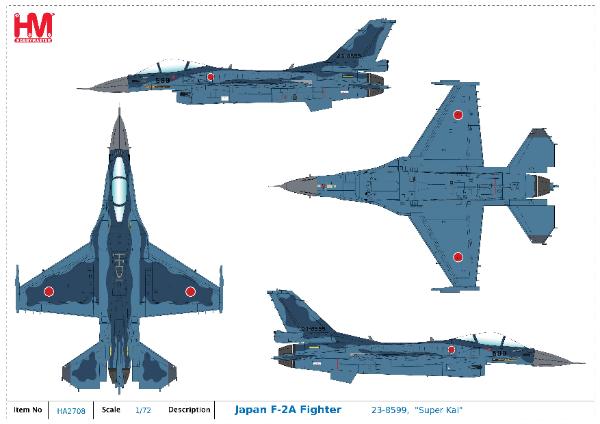Hobby Master 1/72 Air Power Series
HA2708
Japan F-2A Fighter
23-8599, "Super Kai"
|
Die-cast metal.
Superb detailing in 1/72 scale.
Pre-painted with pad applied markings.
Fully assembled.
Weapons that are not permanently attached.
Comes with crew figures
Display stand included.
Option to display model with wheels up or down.
Minimum use of plastic.
Specifications Mitsubishi F-2A
Nickname - Viper Zero
Designation - Single-seat Multi-role fighter
Crew - 1 (or 2 for the F-2B)
Performance
Powerplant: (1) General Electric F110-GE-129 turbofan
Dry thrust - 76 kN (17,000 lbf)
Thrust with afterburner - 131 kN (29,500 lbf)
Maximum speed - Mach 2.0
Range - 520 miles (834 km) on anti-ship mission
Service ceiling - 59,000 ft (18,000 m)
Dimensions
Length - 50 ft 11 in (15.52 m)
Wingspan - 36 ft 6 in (11.13 m)
Height - 15 ft 5 in (4.69 m)
Wing area - 375 ft² (34.84 m²)
Weights
Empty - 21,000 lb (9,527 kg)
Loaded - 33,000 lb (15,000 kg)
Max takeoff - 48,700 lb (22,100 kg)
Armament
(1) 20 mm JM61A1 cannon
Capable of carrying up to 17,820 lb (8,085 kg) weapon load on 11 hard points. They
are located - #1 and #11 at the wing tips, #2-5 and #7-10 under the wings, and #6 under
the fuselage.
Possible Weapons
Air-to-air - AIM-9 Sidewinder, AIM-7 Sparrow, Mitsubishi AAM-3, Mitsubishi AAM-4
Air-to-ground - ASM-1 and ASM-2 anti-ship missiles.
Various free-fall bombs with GCS-1 IIR seeker heads, Mk 82 and JM177 bombs,
CBU-87, JDAM and JLAU-3/A or RL-4 rocket pods.
Others - J/AAQ-2 FLIR
Avionics
Mitsubishi Active Electronically Scanned Array radar system including J/APG-1.
Some differences between the F-2A and the F-16
F-2A has a 25% larger wing area.
F-2A is manufactured using composite materials to reduce overall weight and radar
signature.
F-2A is longer and wider nose to accommodate phased-array radar.
F-2A has a larger tail-plane.
F-2A has a larger air intake.
F-2A has a three-piece cockpit canopy.
F-2A is equipped with a drogue parachute.
|
During the 1980s General Dynamics, the developer of the F-16, proposed another
version of the F-16 called the F-16 Agile Falcon. The US military opted not to get involved
because they were busy upgrading their present fleet as well as developing the new F-
22/JSF. Japan had decided to purchase the F-16 to replace its aging F-1 aircraft but then
decided to develop the F-16 Agile Falcon concept. The new aircraft for the JASDF (Japan
Air Self Defense Force) would be the F-2 and manufactured with a 60/40 split between
Mitsubishi Heavy Industries and Lockheed Martin. Lockheed Martin bought General
Dynamics in 1993. Production started in 1996 with the first aircraft being delivered in
2000. 94 of the F-2 aircraft are scheduled to be manufactured. It might look like an
F-16 but the Mitsubishi F-2 is a completely new fighter. The general shape may say F-16
and a few things that the F-2 and the F-16 have common are the engine, landing gear, air
intake door and the 20 mm gun. But the F-2 has a longer and wider nose to
accommodate phased-array radar with 25% larger wing. It is made from a composite
material to reduce weight and radar signature, a larger tail plane and larger air intake.
The pilot canopy is a stronger three-piece construction. The F-2 is equipped with a
drogue chute just like the NATO version of the F-16. The single seat fighter is the F-2A
while the two seat version is a trainer that is fully Combat capable.
In the early 1980s the Japanese Defense Ministry’s Technical Research and
Development Institute (TRDI) and the Air Development and Test Wing (ADTW) began the
project known as FS-X. The project was to develop a made in Japan fighter to replace
their aging Mitsubishi F-1. During the decision making period Lockheed Martin produced
a large model of what the Mitsubishi / Lockheed Martin aircraft would look like and it was
assigned serial 23-8599. The only place to find this serial number is on the promotional
model.
|
     |
This new site is being updated regularly and it will be much improved before too long. Please be patient, give it time, and check back regularly.
Opportunities for community collaboration are in the works for a little further down the road.
|
|
- This is not a retail site. You cannot buy models here.
- Thanks to Dauntless Aviation for providing web hosting and other support for this site. Real or sim pilot? Check out their stuff!
- This is not an official site of any manufacturer or retailer. Information provided here may be incomplete or in error. Use at your own risk.
- This is not an "advice" site. Please do not contact us asking about these models. Please contact a manufacturer or retailer with your questions or comments.
- Please update your links!
- Update HomePage links from the HMC website to either www.MetalWings.com or, preferably, www.dauntless-soft.com/MetalWings.
- Update your page links to this page from HMCwebsite/HA2708.html to http://www.dauntless-soft.com/MetalWings/HA2708.asp
- This site will be modified over time. We are well aware of its many issues, including missing images and bad formatting.
|
|
© 2026 Dauntless Aviation • 4950C York Road 110, Buckingham, PA, 18912, USA •
Contact Us •
Privacy Policy / Terms / Conditions
|
|

